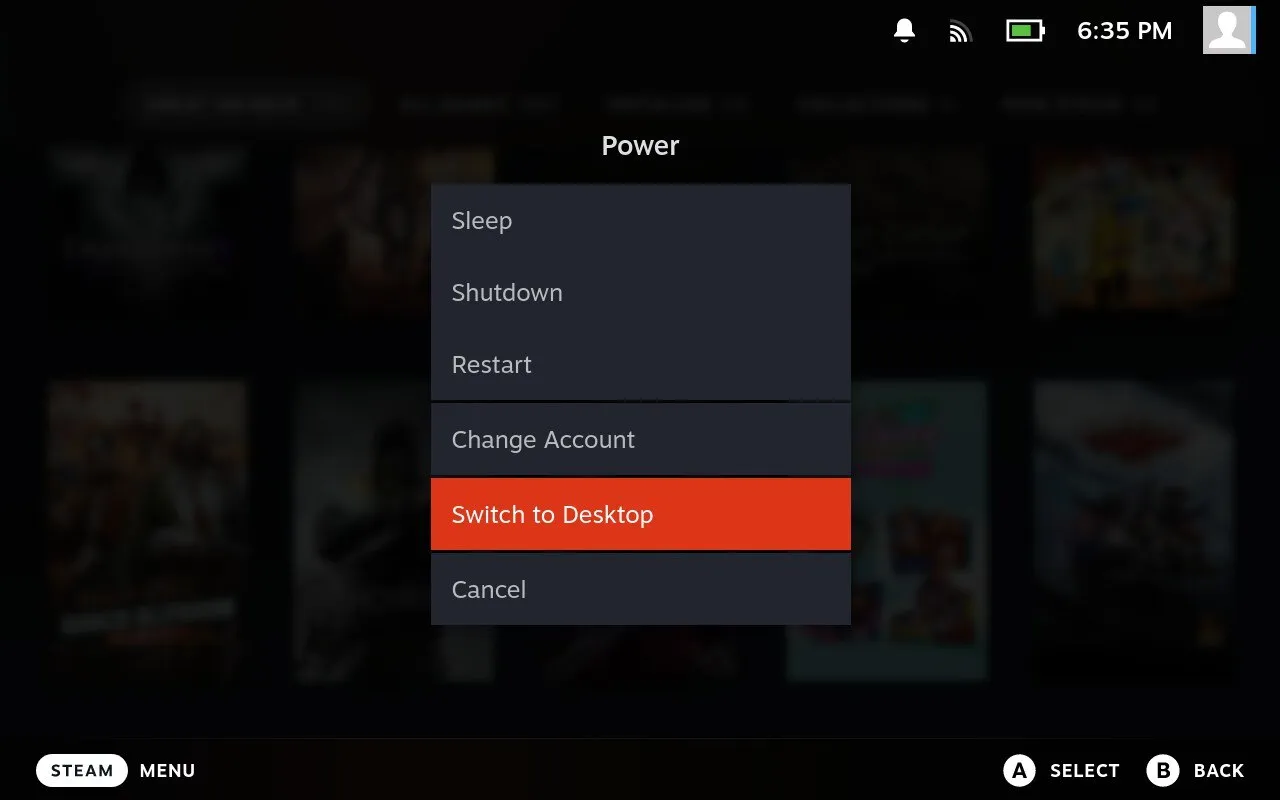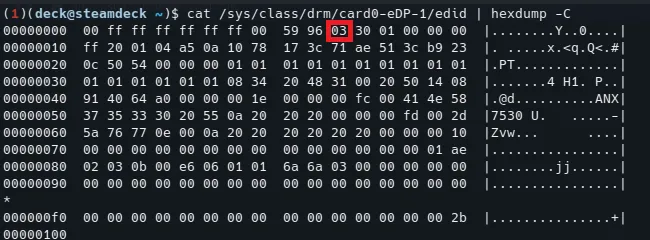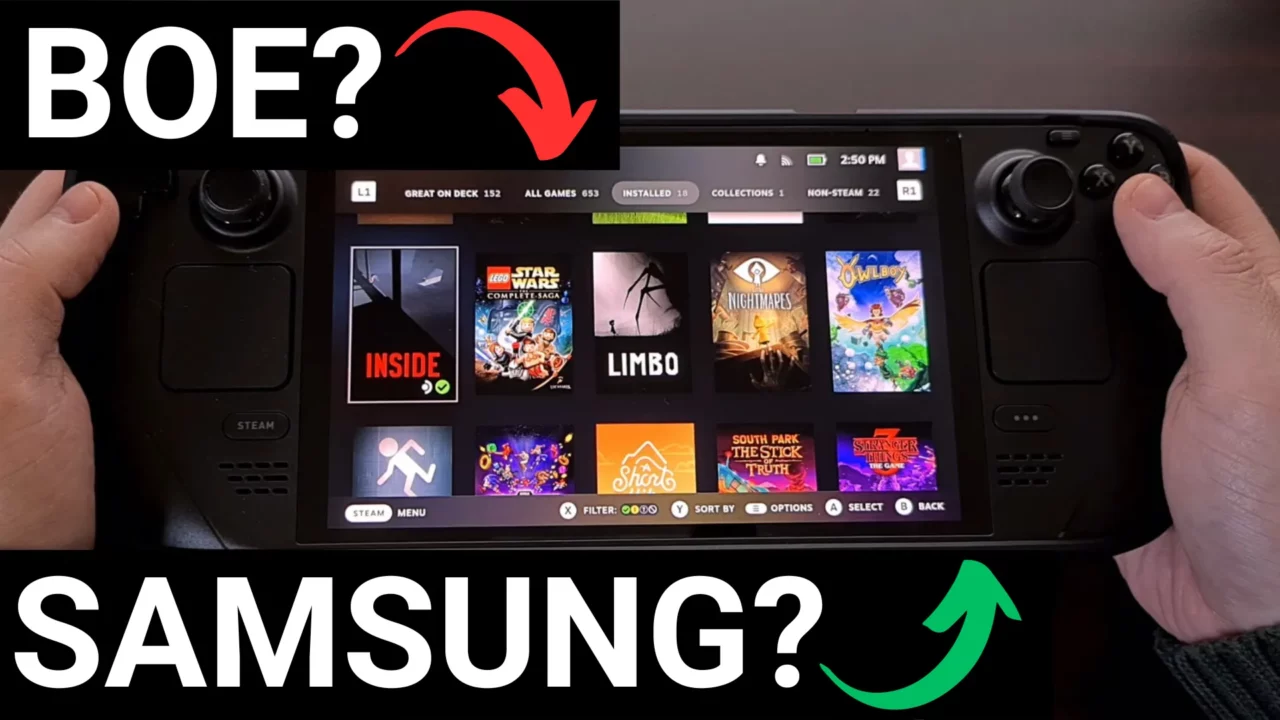When Valve initially launched the LCD version of the Steam Deck, they were only able to source their displays from a company named BOE Display. However, when the OLED variant was released, the community discovered that the company had split their orders between BOE and Samsung.
Once the actual part numbers were discovered, some research uncovered that one of these displays are actually spec’d a bit better than the other.
But before we get into that, let me first show you how to check which OEM supplied the Steam Deck display panel that you currently own. I figured out two different ways this can be done (both of which require a terminal command to be executed) and will be going over both of them here today. I’ll even include the results I got when I did this to my very own OLED Steam Deck.

1. Reboot into Desktop Mode
The first thing you’ll need to do is switch your Steam Deck from Gaming Mode into Desktop Mode. This is required because we need to open up a terminal window and most people do not have this app setup as a shortcut for it. So press the Steam button on the left hand side of your Steam Deck and then select the Power option.
You will then need to select the Switch to Desktop option that appears in the menu.
The Steam Deck will begin to power off and then reboot into what is known as Desktop Mode. This mimics a Windows or Linux desktop experience where we can launch regular Linux apps.
2. Launch the Konsole App
We need to execute a couple commands in a terminal window, and Konsole is a pre-installed app included on the Steam Deck that offers exactly that. You can choose to install your terminal program of choice, but Konsole is able to handle most things you throw at it, so I use it for now.
You can find the Konsole app by clicking on the Steam Deck button in the bottom right corner (basically just the same as a Windows Start button). If you look through the Settings category, you should see the terminal program we’re looking for. Click it and you’ll see a terminal window open up.

3. Execute the Terminal Commands
So we’re going to need to type (or paste) two commands into this window. You should be able to bring up the on-screen keyboard by clicking anywhere in the window and then pressing the X button on the Steam Deck itself. Now go ahead and execute the following two commands. . .
cat /sys/class/drm/card0-eDP-1/edid | hexdump -CThis command can either be typed in manually or pasted. The only important bit is that you type it in exactly as you see here. If you mistype just one character here then it will likely return an error message without you figuring out the manufacturer of the Steam Deck display.
If you look at the image above, you’ll see an example of the results you’ll see after you execute that first command listed here. You want to focus on that second set of numbers and then look at the third entry of the top row. The number you see there will indicate which company supplied your Steam Deck panel.
Here’s how to decipher that code. . .
- 01 = LCD Panel from BOE with an 800×1280 pixel resolution at 59.998545Hz (basically 60)
- 02 = Retired
- 03 = OLED Panel from Samsung with an 800×1280 pixel resolution at 90.003892Hz (basically 90)
- 04 = OLED Panel from BOE Display with an 800×1280 pixel resolution at 90.061454Hz (basically 90)
So now you should have an idea as to which manufacturer made the display in your Steam Deck. But let’s double check our work with the second command.
xrandr --verbose | grep MHz
After you execute this command you will get a result that looks like this. . .
- 800×1200 (0x55) 133.200MHz +HSync +VSync *current +preferred
And we’re going to focus on the MHz number listed in the response. Because if yours says the same thing mine says and is listed at 133.200MHz it means your Steam Deck panel is made by Samsung.
If, however, you see a number that’s close to or equal to 102.00MHz then that means it was BOE Display who made your Steam Deck panel.
Does it Matter Which Company Makes the Steam Deck Display?
If you don’t plan on installing any unofficial modifications to the SteamOS software installed on your Steam Deck, then no, it does not matter. There have been some speculation that one OEM ships panels with more dead pixels than the other. That is not something that has been proven, though.
There is a modder that has recently released something for the Steam Deck that will overclock the screen.
That means that when it is installed, you can configure it so that it will run at 120Hz rather than 90Hz. The thing is, this mod does not seem to be compatible with the OLED Steam Deck that uses a display from Samsung. It has to use more bandwidth just to reach the 90Hz level that there isn’t any room for improvements past around 100Hz (if you’re lucky).
But if you have one that has a display from BOE then it looks like you can install this mod and it will bump your device up to 120Hz. That will result in your games being more responsive while also increasing performance up to 120 frames per second when possible.
Checking Which OEM Makes the Steam Deck Display Panel
Conclusion
I am a bit saddened to find out that my OLED Steam Deck has a panel made by Samsung. But it’s not something that makes the experience worse. This Steam Deck was advertised to run at 90Hz and that’s exactly what it does. I can’t be mad at Valve or Samsung for this unit not being overclockable.
I do hear that all of the Limited Edition Steam Deck OLED devices ship with the BOE Display panel, though. Which is nice. So at least those who paid a bit more will be guaranteed to get a better display. I purchased the 512GB model so I could avoid the etched glass, though.
